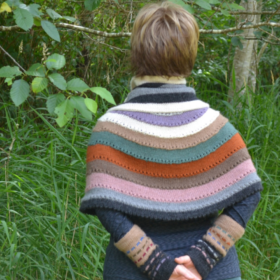
LaCapa and DeColores
buy the pattern La Capa and DeColores, a cape and pair of half-sleeves, may be worn alone or together. The knitting is simple and serene,
After ten days in Perú, my heartbeat now pulses with a Peruvian rhythm and my dreams float like soft alpaca mist rising in thermals up Andean peaks. I am going to try to tell you about our trip but I shall fail utterly to convey the grandeur and life-altering nature of the experience.
Our plan was to scout out pockets of traditional knitting in Perú in order to shape a 2014 knitting tour. We soon discovered that if we walked around while knitting, knitters, mostly older people, spontaneously reached out to us with radiant smiles and we instantly found ourselves together in that deep space of comfort and kindred recognition that knitters know so well.
Here my friend on the left is knitting my grandson’s sock (she just learned how to do the Coriolis band) and I am knitting her sleeve—we traded for a while. It took her approximately 3 seconds to understand how to knit on 2 circular needles. This sort of thing happened again and again.

My companions were Jim “Pecos” Petkiewicz of Frog Tree Yarns and Community Links International, and his colleague Arturo Ortega. Pecos and his extended family have been my beloved friends for years. From the moment in the airport when Pecos said I was his sister so I could board early with him, we agreed we really were sister and brother. Then Arturo met us in Lima and gained a sister (hermana), and I was surrounded by two dear brothers (hermanos) from that moment on. Here are my hermanos.

Pecos’ family lived for years in Latin America and are bilingual, and Arturo lives in Mexico. I’d been studying Spanish diligently for six months. I was tongue-tied much of the time, but in Perú the delicious sounds and sensations of español melted through me and my abilities slowly grew deeper.
Arequipa, our first destination, is in southern Perú, nearly 7, 000 feet in elevation. Snow-topped volcanos circled us, with the highest, Chachani, nearly 20,000 feet.

Our hotel was a little sanctuary near the center of the city, with a variety of quaint buildings, a small pool, gardens, and a restaurant. Mornings we enjoyed fresh fruit juices, avocado, tomato, ham, cheese, eggs, breads, and grainy cereals like quinoa. Arturo brought coffee from Mexico that he helped grow and process, along with a small French Press. We were spoiled.

We visited the Plaza de Armas and admired the fountain,

wandered through the local mercado

and spent several hours exploring the beautiful and labyrinthine Santa Catalina Monastery, built in 1579.

One enters through this arch.

And then the color changes begin. Azul…

Rojo…

azul y gris…

Arturo taught me a new word: tragaluz—a hole that carries light.

From the highest point of the monastery we could see the mountains over a turbulent sea of rooftops.

Walking back to the hotel, children wearing hand-knit sweaters were playing in the streets…

That evening we made friends with our server Gerda, a knitter. She mischievously lifted Pecos’ knitting out of his hands, vanished for ten minutes and brought it back with an inch completed. From her we learned that garter stitch is called “Santa Clara” in Perú. Pecos is very pleased.

In Arequipa we also spent a mesmerizing afternoon with a Frog Tree Yarn partner, where I witnessed the astounding speed, agility, and technique of this woman, who could wind 12-15 skeins a minute. When she let me try, I soon realized I had missed many steps because she was so fast I couldn’t see everything she was doing (notice the blurred hand). I made quite a fool of myself, and she was very nice about my clumsiness. If there were an Olympic event of skein-winding, she would win a gold medal. She is my hero.

There was were lavish coils of silken alpaca, like soft-serve cones longing to melt into yarn…

And to our astonishment, a queso (a huge cheese-shaped bundle) of vicuña fiber that must have weighed 400 pounds, all wrapped in white cloth and having a gentle bath. Our guide opened it and gave me a little bit. I am not telling you where I have hidden it. Someday I shall spin it up, maybe when I am 90 years old.

We soon fell into the habit of having our main meal midday and then enjoying a simple supper of sopa in the evening. I think my very favorite was Sopa de Criollo, a rich broth with milk and bits of chicken or beef, noodles, a poached egg, and a few vegetables. I slept like a baby (or a wawa, as they are called in Peru) every night, out of sheer happiness and a belly lightly filled with warm soup.

We also made a trip to the Colca Canyon and saw dozens of condors, who have a striking white collar and long wing-fingers. They ride the thermals in the morning only, so we arose before 3 am to board our bus, drove into a sub-freezing climate, and later in the day broiled in the sun, then returned to our hotel later in the evening. It was worth it.

During this long day, we rode over the top of the world, nearly 16,000 feet high. I was able to walk and that made me very happy. One of my favorite things on top of the world was this moss, which grows only 1 centimeter a year and thrives as if it has a water source when there is none visible. Most of these are over a century old. So round and green and alive, and oh so beautiful.

From Arequipa we flew to Puno, on the sparkling Lake Titicaca, the largest lake in South America, with Bolivia bordering the far shore. I had wondered how I would do at the altitude of 12,500 (although I was most encouraged by my ability to self-ambulate at 16,000), and it turned out that I was entirely fine. In fact, I thrived; I have since decided that my body loves high altitudes and is stronger and more vigorous in that environment.
But what excited me most about this striking landscape was that everywhere I looked there were knitters, sitting in doorsteps, walking down the street, in the mercados, everywhere. The first one I saw, a young woman walking briskly with a friend while knitting a cabled sweater front, I chased down the street in case she was the only one. Soon enough I realized that either I was dreaming or had landed in a knitter’s heaven. Driving down a road, I managed to snap this photo,

and this one.

At the very large artisan market, halfway up the first aisle we made such good friends that we planted ourselves with them and never went farther. The half-dozen tejedoras were indeed a kindness of knitters (in case you haven’t heard this before, a flock of birds, a herd of sheep, and a kindness of knitters). They pulled out a stool for me to sit on and brought out their bag of coca leaves to share, extolling their virtues for health (the leaves contain less than 1% of the compound that must be chemically extracted to produce cocaine, and chewing coca leaves has been used by indigenous people for centuries to support high-altitude health). After much intercambio (interchange of knowledge and enthusiasm and friendship) we promised to return next year.

I had to be dragged away and spent the afternoon asking Pecos and Arturo when I could go back to be with my friends. If it weren’t for my hermanos I would still be there.

Off we went to visit a floating island, sailing through half-submerged fields of reeds which are used to build both islands and graceful, seaworthy boats. We visited with local women, whose tradition is not knitting, but embroidery of beautiful cloth murals. They were very curious about our knitting, all the same.

And I was very interested in this cat. Thinking he might be bothering us, the owner picked him up mother-cat-style, which is why he looks immobilized; she was firm but gentle, and the cat is fine. I later watched the cat sneak off with a piece of fish.
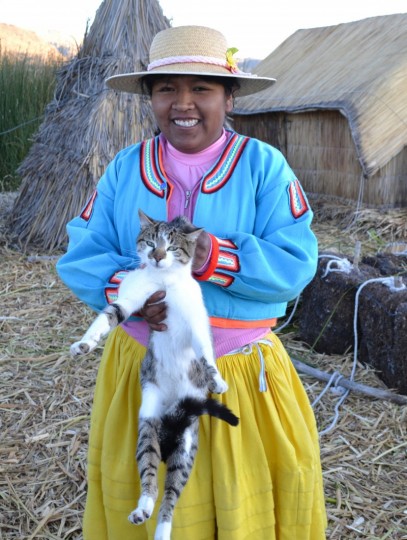
From the floating island we watched the sun go down and turn Puno to gold.
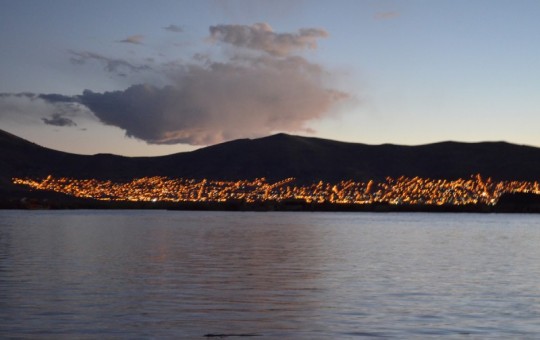
And sadly, in the morning we had to leave, and head to Cusco. I complained once more that I wanted to go see my friends in the market, and my brothers just shook their heads. Every time we left a place, I feared I could not love the next one as much, and I was always wrong. Always. Cusco is magical…
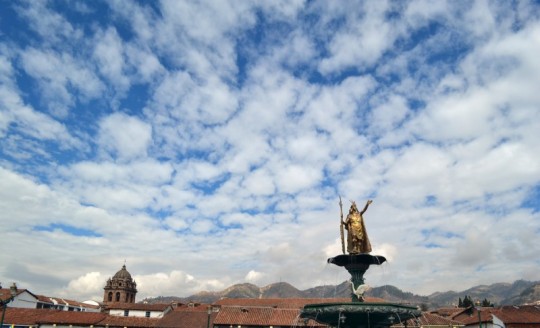
In Cusco I met the internationally revered Nilda Callañaupa, director and founder of the Center for Traditional Textiles of Cusco, whose decades of work for the region’s artisans has preserved their ability to pass on their age-old skills and to sustain their families in many villages. The textiles for sale in the Center were miles above the quality of anything else we came across, visually and tactilely stunning and representing hundreds of hours of highly skilled artistry, including handspinning, natural dyeing, preparing looms, weaving, and knitting. Everything is of museum quality (and the center includes a small museum that is breath-taking) and so beautiful that it is hard to leave.

Cusco is also a gateway to Machu Picchu. After an hour and a half bus ride, we boarded a charming train that wound for two hours along a river, with the mountainsides becoming more and more like a jungle, followed by a half hour bus ride on switchbacks up a nearly vertical mountain. I am a passionate lover of mountains and have never seen any so tall and erect, or so verdant, with soft clouds resting halfway down and slowly drifting upward, rubbing against the mountainsides like a purring cat. Machu Picchu felt like home to me. Jim and Arturo had been there several times before, and knew the best routes. We first climbed up high, where we had a view of everything. I knitted for a while.
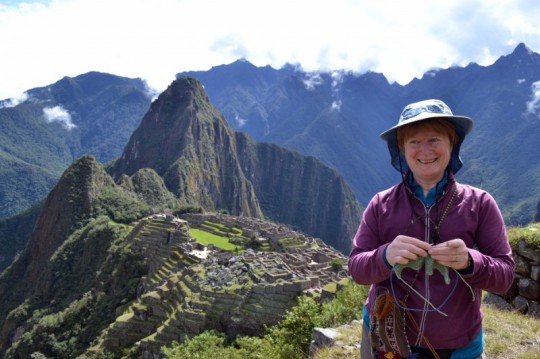
Arturo played for us.
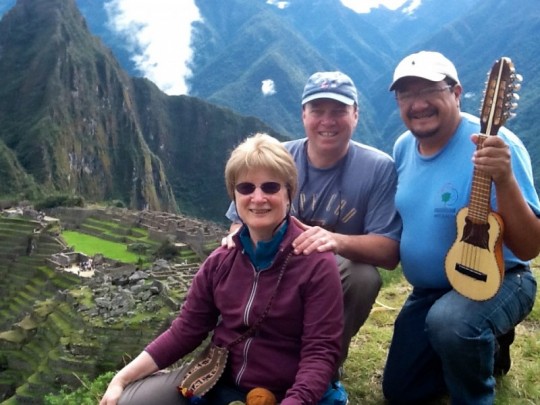
And then we began our descent to explore the ruins below.

My brothers were very careful to keep me from going over the edge, and I watched over them too.
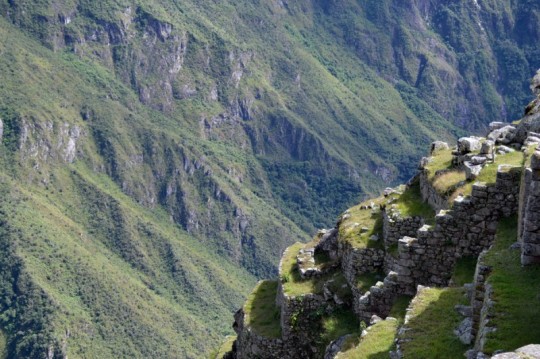
Being in this amazing land-and-sky-scape was transcendent. The experience filled me so purely that it seems ever-present still. Do you see how the rocks in the foreground imitate the peaks in the distance?
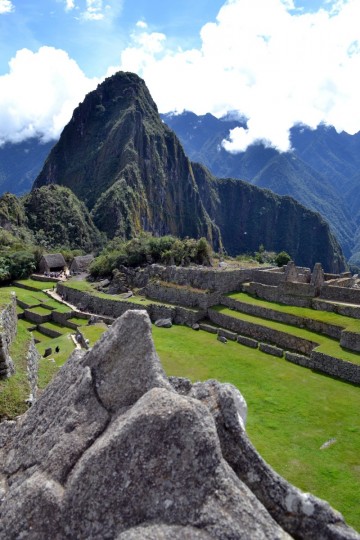
The following day we went to Chinchero, which we had visited a few days earlier. I was so very happy to return. About an hour from Cusco, this village is where Nilda Callañaupa grew up, and is the original location of her Center for Traditional Textiles of Cusco. Abby Franquemont, who also grew up in Chinchero, later told me that it is known as the City of Rainbows. We had a double. When I look at the photos they seem unreal, but this really happened.

Nilda and I reviewed a collection of chullos, the traditional Andean knitted hat with earflaps, each region distinctive, and she explained the different styles of colorwork designs, the varieties of earflaps, and how children’s chullos vary from those of adults. I purchased about a dozen to study.
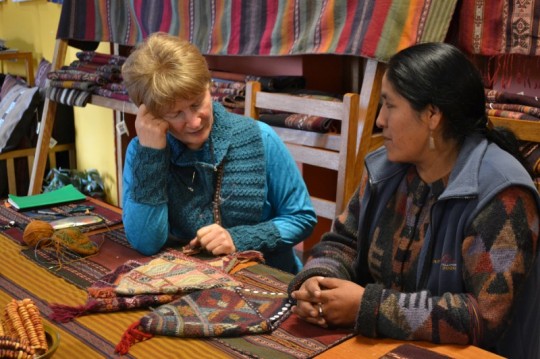
In the courtyard I sat on the grass with local knitters to talk and share. My friends are trying out the Coriolis Band, crossed stitches, and tendrils on a bolsillo (bag) that I was working on, and which I demonstrated for them. Never have I met such adept knitters, who learn and retain information so quickly.

When you see how chullos are knit, you begin to understand how adept they really are. Chullos are knit at a very fine gauge and every single stitch is interchanged with several other colors in a particular order that seems to shift depending on factors I could not identify. The plucking and rearrangement of the strands is like watching a virtuoso guitar player. It happens so fast that I could not follow it. Someday, on a future trip to Perú, I will learn this.
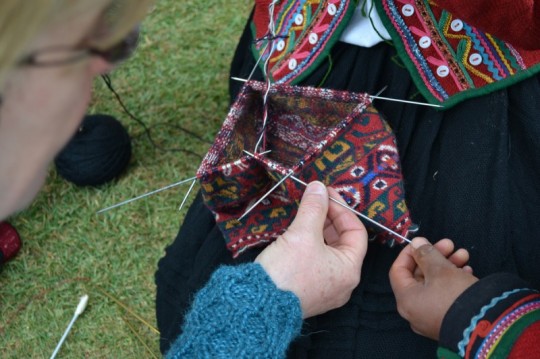
I shared Judy’s Magic Cast-On and Jeny’s Surprisingly Stretchy Bind-Off. Like knitters everywhere who learn these magical techniques, my friends were delighted to have solutions to age-old problems.
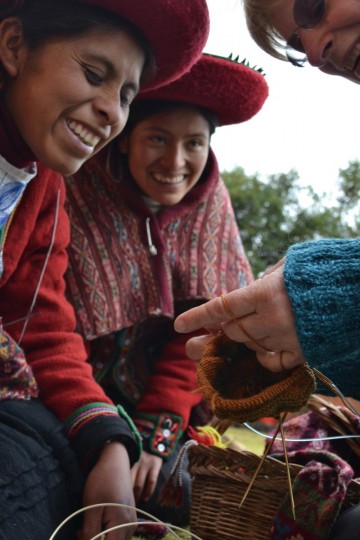
And someday, on a future trip to Perú, I will learn backstrap weaving. If only I had parallel lifetimes, I would send several of me to be born in Chinchero and learn to spin, dye, weave, and knit as they do.
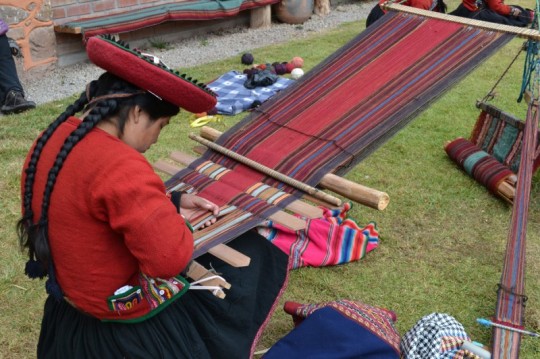
I longed to bring this beautiful piece of weaving home with me, but had already spent too much on my new chullo collection. I could literally taste the colors and feel their energy. This piece represents hundreds of hours of shepherding, shearing, handspinning, gathering of dyestuffs, vegetable dyeing, warping, weaving, and finishing. At both the Cusco and Chinchero centers, there are many pieces like this on display and available for purchase. It is a miracle. The centers alone are worth a trip to Peru.
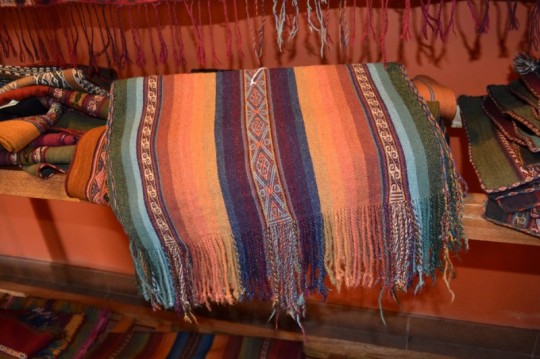
On our way back to Cusco as night fell, we paused here to look up at ruins on the hillside and down on the Sacred Valley.

Back in our hotel, catching up on emails before we went off to find the soup of the evening, with only one more day before leaving Perú, I began to dissolve, as if a membrane that had always contained me had broken. “You should have warned me,” I told Pecos in a trembling voice, “I had no idea it would affect me like this.”
I didn’t have to explain what I meant. Pecos had told me what it was like for him when he, his wife Mags and their two school-age children had made the difficult decision to leave Latin America a decade ago to be closer to their families in the United States. He had warned me; I just hadn’t realized how deep the experience could go, and how it could uproot and dissolve so much of what I normally think and feel. My world had swollen like a pregnant woman’s belly over these ten days in Peru; my world was now round and radiant and urgent and I realized that I had not known it had been flat before. I went up to my room to weep before returning for dinner, tears that were nonverbal, of grief, of joy, of bewilderment, and most of all, of a fierce new love for that which pulses like red earth and musical languages and bright black eyes and intelligent hands of the sacred people and land of Perú.
On my final day (my brothers were staying a few days beyond me to work on other things) we went to the Plaza de Armas, where Arturo knew a woman would be selling the best tamales in the world. I love tamales. They were perfect. So perfect and satisfying that one was enough. It was soft, warm, delicate, and succulent.
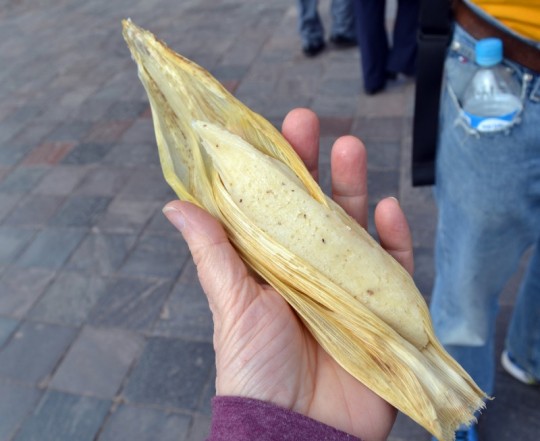
We shall return in early June of 2014 with a group of knitters and will follow a similar route, with improvements (as if that is possible!). The trip will support Community Links International, which helps traditional artisans in both Latin and North America support themselves, keeping families and cultures and communities intact, and also focuses on environmental work and community-based education. Every day my brothers and I sat down and recorded observations and ideas and places and people and made lists of things to tell our knitters so they will be well-prepared. I’m working on a detailed glossary of knitting terms and useful sentences in Spanish and English, which will help everyone communicate with local knitters. If you are interested in the trip, email me. It will be an active trip, so you will need to be able to easily carry a day pack (of say around 20 pounds) as you walk on hilly streets at high elevations. It’s a great motivation to get in shape!
Strangely, I feel ten years younger than before going to Perú. We ate delicious, nutritious food, were very active, and I slept deeply. I can’t know what anyone else’s experience will be, but consider yourself warned if you join us. You may dissolve as I have; you may choose to return again and again, or to find your own Latin America closer to home. You may be changed forever. Perhaps like me, your world is flat and you have not known that; the trip may make your world round as a woman’s nine-month belly, ready to burst open with newborn possibility.

buy the pattern La Capa and DeColores, a cape and pair of half-sleeves, may be worn alone or together. The knitting is simple and serene,

buy the ebook Purchase this eBook for $20 with all 25 patterns and live video links. This ebook is a set of 9 Folios,

To all my dear friends out there…I want to let you know that I am dying. Don’t be worried, it’s apparently part of life! When
©2024. Let the River Carry You, LLC.